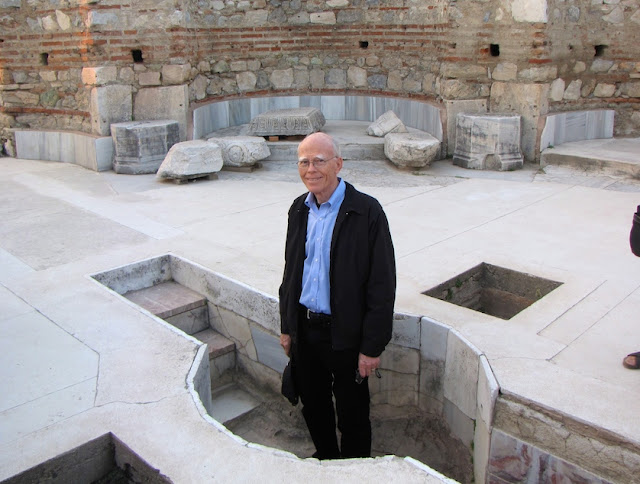We began our day in Smyrna--modern Izmir where we have been staying. This is a huge city. Both the day we arrived and yesterday when we went to Pergamum, nearly an hour of the drive was just getting through Izmir, and that mainly on freeways. The agora (market place) of the ancient city has been excavated, surrounded by city.
On the far side stood a basilica, originally more like a court house than a church. The basement remains.
Great views through the vaulting.
The skies were hazy most of our drive to Selcuk, the modern city near ancient Ephesus, but they cleared when we arrived. A major problem here over the millenia has been rivers silting up harbors, so the sea is constantly retreating from the port cities. As everywhere, there are plenty of tourist shops and tea shops. We got a kick out of this one advertising genuine fake watches.
Paul taught for three years in Ephesus, a huge center even then.
As a former librarian and current lover of books, I thought I needed my picture taken outside the Library of Celsus, built by his son to honor his father and a way of having him buried inside the city. (The library wasn't built until 117 AD so it wasn't there when Paul was.) This facade is a modern reconstruction using original materials. We have seen quite a few of those. The practice is contraversial, but it certainly draws in the tourists. Today it was Turkish school children, noisy but enthusiasitc about their history.
The city was famous for the temple of Artemis (Roman Diana). This fountain on a main street was dedicated to her. That's her image on the keystone.
It was here that the silversmith Demetrius felt his business making souvenir images of the goddess slipping away. He stirred up a crowd that surged down this street from the business district toward the theater. (Okay, so these are theologians, not irate businessmen, and no one was shouting except the school children.)
They surged into the theater and shouted for two hours. The acoustics here are fabulous. One of our colleagues stood at the bottom and read all of Acts 19. We could hear every word. Can't imagine 25,000 screaming, "Great is Artemis of the Ephesians!"
We ended up singing "Amazing Grace". Not sure that was actually legal here, but it was moving and no one distrubed us. Here's another view of the theater that includes the street down to the now-silted harbor.
Mary, mother of Jesus lived with the Apostle John who became Bishop of Ephesus. Some claim she died in Jerusalem and John only came here after her death. Others insist she came here with him and is buried here. These are the remains of a church dedicated to her--the church where a fourth century church council declared her "Mother of God" not just "Mother of Christ" because Jesus was fully God at his birth. (The Council of Ephesus condemned Nestorianism [Christ had two separate natures] and Pelagianism [no original sin].)
The church of Saint John the Theologian is on the hill outside the Roman city of Ephesus, but well within the modern city of Selcuk. Saint John is buried there at the crossing of the arms in the cruciform building.
They evidently practiced full immersion baptism in the sixth century when the church was built since this baptistry doesn't look suitable for sprinking babies.
A fourteenth-century Turish fort crowns the hill above the ruins of the Church of St. John. I took this for my grandchildren more than anything--a real castle.
Tomorrow we disperse to our various countries. We have been 48 from 16 different countries, more if you count country of origin and country of work. It has been a good time of sharing and getting acquainted with others involved in theological education as well as seeing significant places in our shared history.
We are off to Istanbul/Byzantium/Constantinople for a day before heading home.



















































